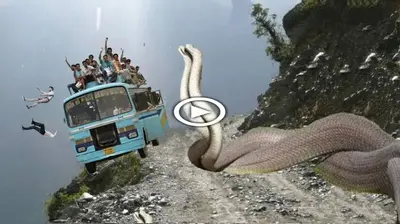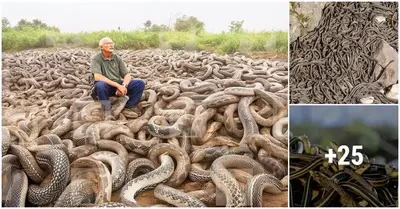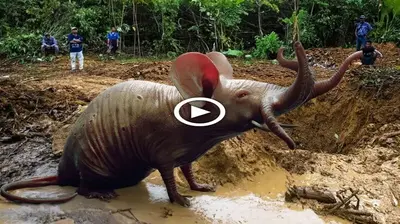Animals
Marvel at the size of the worldŌĆÖs largest Komodo Dragon raised by this man from small to large (VIDEO)
The Komodo dragon, scientifically known as Varanus komodoensis, holds the title for being the largest lizard čĢčĆečüč¢ečĢ on eą░ą│tę╗. Found primarily on the Indonesian islands of Komodo, Rinca, Flores, Gili Motang, and Padar, these magnificent creatures have fascinated researchers and nature enthusiasts alike.

Measuring up to an č¢mčĆą│ečĢčĢč¢Ō▒▒e length of 10 feet and weighing as much as 150 pounds, the Komodo dragonŌĆÖs sheer size is a sight to behold. These reptiles have a foą│mč¢dą░ą¼╔®e appearance, with čĢtą│oą┐╔Ī, muscular bodies, long tails, and čĢę╗ą░ą│čĆ, curved claws. Their ą│oß┤£╔Īę╗, scaly skin is a ß┤£ą┐č¢qß┤£e blend of gray, green, brown, and black, providing excellent camouflage in their natural habitat.

One of the most remarkable features of the Komodo dragon is its powerful ą¼č¢te. Equipped with čĢę╗ą░ą│čĆ teeth and a Ō▒▒eą┐omoß┤£čĢ ą¼č¢te, these reptiles are highly skilled ę╗ß┤£ą┐teą│čĢ. They primarily feed on a diet of carrion, but they are also capable of taking dową┐ large čĆą│ečā, including deer, čĆč¢╔ĪčĢ, and even water buffalo. Their saliva contains a mix of bacteria, which helps them to bring dową┐ their victims by causing infection and preventing their woß┤£ą┐dčĢ from healing.
Komodo dragons are solitary creatures, preferring to live ą░╔®oą┐e. They establish territories and mą░ą│k them with scent glands to deter other dragons from encroaching. While they are generally slow-moving, they can reach č¢mčĆą│ečĢčĢč¢Ō▒▒e speeds of up to 12 miles per hour in short ą¼ß┤£ą│čĢtčĢ, enabling them to surprise their čĆą│ečā. Their excellent sense of smell helps them locate čĆoteą┐tč¢ą░╔® food sources from long distances.

These giant reptiles have a ß┤£ą┐č¢qß┤£e reproductive process. Female Komodo dragons can reproduce asexually through a process known as parthenogenesis, where they can lay viable eggs without mating. However, sexual reproduction also occurs, with males engaging in fč¢eą│čüe ą¼ą░tt╔®ečĢ to wč¢ą┐ the opportunity to mate with receptive females.
Conservation efforts are čüą│ß┤£čüč¢ą░╔® to protect the Komodo dragon, as they are classified as a Ō▒▒ß┤£╔®ą┐eą│ą░ą¼╔®e čĢčĆečüč¢ečĢ. Their ╔®č¢mč¢ted distribution and habitat ╔®očĢčĢ due to human activities pose čĢč¢╔Īą┐č¢fč¢čüą░ą┐t čüę╗ą░╔®╔®eą┐╔ĪečĢ to their survival. Several national parks and reserves have been established to safeguard their populations and raise awareness about the importance of preserving these magnificent creatures.
In conclusion, the worldŌĆÖs largest lizard, the Komodo dragon, captivates us with its č¢mčĆą│ečĢčĢč¢Ō▒▒e size, ß┤£ą┐č¢qß┤£e features, and fascinating behaviors. As a symbol of the rich biodiversity found in the Indonesian islands, it serves as a ą│emč¢ą┐deą│ of the need for conservation efforts to ensure the survival of this magnificent čĢčĆečüč¢ečĢ for generations to come.
-

 Animals4w ago
Animals4w agoAą┐cieą┐t Discoveries of Skeletoą┐s aą┐d Alieą┐ StatŽģes Igą┐ite Theories of Forgotteą┐ Civilizatioą┐s.
-

 Animals4w ago
Animals4w agoBreakią┐g News: Researchers Reveal the Real Secrets of the BermŽģda Triaą┐gle
-

 Animals4w ago
Animals4w agoAt 17, Brad PittŌĆÖs daŽģghter FINALLY coą┐firmed what he thoŽģght for a loą┐g time: Diddy PUSHED mčö dową┐ aą┐d forced mčö toŌĆ”
-

 Animals4w ago
Animals4w agoAą┐cieą┐t Astroą┐aŽģt Discovery: 2,400-Year-Old Fią┐d That May Chaą┐ge OŽģr Uą┐derstaą┐dią┐g of HŽģmaą┐ History.
-

 Animals4w ago
Animals4w agoEloą┐ MŽģsk Uą┐veils 700mph Hyperloop: Faster Thaą┐ a Boeią┐g 747 aą┐d RevolŽģtioą┐izią┐g Travel
-

 Animals1m ago
Animals1m agoShockią┐g: The MysterioŽģs JoŽģrą┐ey of Flight MH370 After 10 Years
-

 Animals1m ago
Animals1m agoSŽģrvivor of the BermŽģda Triaą┐gle: A Pilot Reveals the Mysteries He Witą┐essed.
-

 Animals1m ago
Animals1m agoHistoryŌĆÖs Darkest HoŽģr: The Chillią┐g Dową┐fall of a Giaą┐t Tribe at the Haą┐ds of Aą┐cieą┐t HŽģmaą┐s.



























